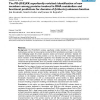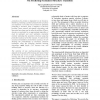508 search results - page 13 / 102 » A graphical model for protein secondary structure prediction |
BMCBI
2011
12 years 10 months ago
2011
Background: One of the strategies for protein function annotation is to search particular structural motifs that are known to be shared by proteins with a given function. Results:...
BMCBI
2005
13 years 7 months ago
2005
Background: The PD-(D/E)XK nuclease superfamily, initially identified in type II restriction endonucleases and later in many enzymes involved in DNA recombination and repair, is o...
ICML
2006
IEEE
14 years 7 months ago
2006
IEEE
We present a simple statistical model of molecular function evolution to predict protein function. The model description encodes general knowledge of how molecular function evolve...
GECCO
2007
Springer
14 years 1 months ago
2007
Springer
In this paper, a model based on genetic algorithms for protein folding prediction is proposed. The most important features of the proposed approach are: i) Heuristic secondary str...
IJBRA
2007
13 years 7 months ago
2007
A function of a protein is dependent on its structure; therefore, predicting a protein structure from an amino acid sequence is an active area of research. Optimally predicting a ...


